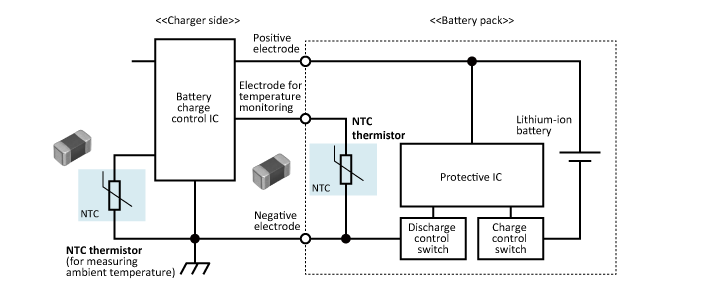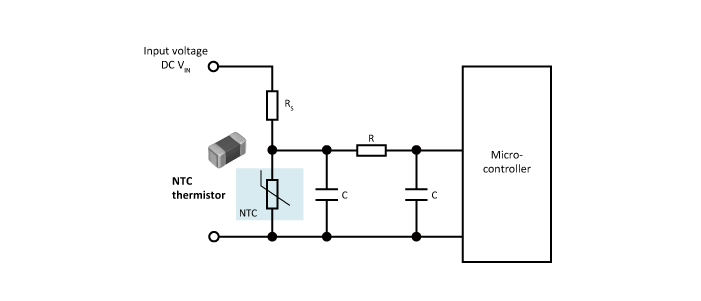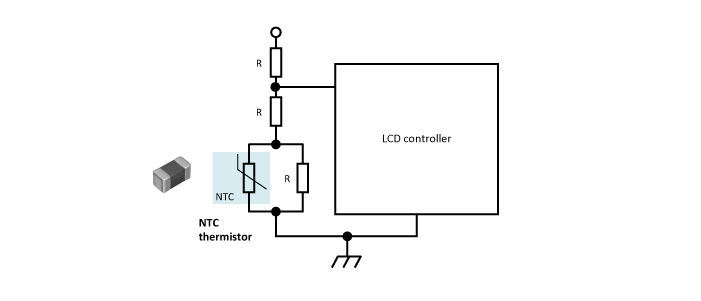
How to Use Temperature Protection Devices – NTC Thermistors
- Posted by doEEEt Media Group
- On October 24, 2020
- 0
NTC thermistors are heat-sensitive resistor elements of which resistance values rapidly decrease with rise of temperature. With this property, they are used as temperature protection devices for protecting circuits from overheating as well as temperature sensors. TDK offers various sizes of both TDK brand and EPCOS brand SMD NTC thermistors by capitalizing on our accumulated material technologies and a multilayer processing technology. This article describes temperature protection device applications for temperature detection and temperature compensation.
Advantages of SMD NTC thermistors
NTC thermistors are temperature-sensitive resistor elements using semiconductor ceramics with negative temperature coefficients (NTC). That means that the resistance decreases exponentially with rising temperature. The steeper the RT curve, the greater the change in resistance within a specified temperature range. With this property, they are often used as temperature sensors and also used as temperature protection devices for purposes such as temperature measurement and temperature compensation.
Temperature compensation is the ability of a circuit to react to changing temperatures and initiate corrective actions in order to ensure stable operation (controlling) and protect against over- or under-temperature. For example, the operation of an electronic circuit using a transistor or a crystal resonator becomes subtly unstable with temperature changes. Owing to their high negative temperature coefficient, NTC thermistors are particularly suitable for compensating a circuit’s undesirable response to temperature changes. Two examples are working point stabilization of power electronics and brightness control of LCD displays.
NTC thermistors
are available in many different designs, including disk, glass-encapsulated diode, resin coated leaded, and SMD types. SMD NTC thermistors based on multilayer technology are the first choice when temperature protection on a PCB board is needed. The following are applications of SMD NTC thermistors as temperature protection devices for purposes such as temperature detection and temperature compensation.
The NTC thermistors referred to in the text and diagrams are SMD NTC thermistors. Also, circuit diagrams are simplified.
Sample application: Temperature detection and temperature compensation for smartphones and tablets
Many NTC thermistors are used in smartphones and tablets for temperature detection and temperature compensation.

Fig. 1: Major temperature detection and temperature compensation applications of NTC thermistors in smartphones and tablets
The basic circuit is a voltage-dividing circuit with an NTC thermistor and a fixed resistor connected in series. The resistance value of an NTC thermistor placed near a heat generating part such as a CPU or a power module decreases with rise of temperature and changes the output voltage of the voltage-dividing circuit.
This change is sent to a microcontroller to initiate temperature compensation actions and protect circuit components from overheating.

Fig. 2: Basic circuits for temperature detection and temperature compensation
Sample application: Temperature detection for battery packs of mobile devices
All rechargeable batteries and lithium ion batteries in particular must be monitored and protected by smart charging circuits, as the mobile communication device drawing power from the batteries must operate in a variety of environments, including low and high-temperature operation.
As preferred temperature detection devices NTC thermistors are used in the protective circuitry. NTC thermistors can detect the ambient temperature for different purposes, depending on the battery system. Especially for quick charging the ambient temperature has to be measured, as not all batteries allow the charging in the hot and cold temperature range. Usually charging temperatures of 0 °C up to 45 °c for slow charging, and 5 °C, 10 °C up to 45 °C for quick charging are recommended by the battery pack manufacturers depending on the battery chemistry.
The NTC thermistor is part of a smart charging control unit (see circuit below), which assures that the ambient temperature is in the range allowing quick charging. During charging the NTC thermistor repeatedly measures the temperature all 5 to 10 seconds and can detect a rise in the battery cell’s temperature at the end of the charging cycle or caused by abnormal charging conditions.
During discharging NTC thermistors also perform temperature compensation for the voltage measurement, which helps to measure the remaining charge in the battery.

Fig. 3: Temperature detection for battery packs of mobile devices
Sample application: Temperature detection for microcontrollers
Microcontrollers of smartphones and other devices must be protected from overheating to ensure their operation reliability. The diagram below shows a microcontroller temperature protection circuit that employs a voltage-dividing circuit consisting of a combination of NTC thermistor and fixed resistors RS.
When an overcurrent flows, the temperature of the NTC thermistor rises and its resistance decreases, thus suppressing the drive voltage of the microcontroller. In order to achieve effective temperature protection small SMD NTC thermistors and resistors are mounted either on the circuit board or the heat generating part.

Fig. 4: Temperature detection for microcontrollers
Sample application: Temperature detection for LED lighting systems
In many portable electronic solutions, light-emitting diodes (LEDs) are widely used in general lighting and automotive lighting, where high brightness becoming increasingly popular. The solution is high-brightness LEDs (HBLEDs), which present numerous advantages over conventional lighting, but like any other semiconductor device they generate heat. One of the challenges is consequently thermal management. Generally speaking, high-quality LEDs are robust devices that can operate in excess of 100,000 hours when properly handled. However, high temperatures can significantly shorten their lifetime and negatively impact their brightness. To guarantee maximum lifetime, LED manufacturers usually recommend that current derating start at temperatures between 50 °C and 80 °C. Without temperature control the designer must ensure that the temperature never exceeds the recommended derating threshold of the LED, or limit current by a resistor to 57% of the maximum rating, which sacrifices the full LED brightness. That makes NTC thermistors the preferred choice for temperature sensing and control in lighting due to their attractive price/performance ratio. They enable LEDs to be used at full operating capability for a given lifetime, meaning higher current at lower ambient temperature and adapted lower current when temperature increases. This not only enhances LED lifetime, this also guarantees good lumen output. For the best performance the NTC sensing thermistor should be located close to the LEDs or in the hotspot of the LED board.
Different topologies can be used based on specific IC LED drivers. An NTC thermistor can operate in a resistor network where the sense voltage can indirectly control the LED current by influencing pulse-width modulation (PWM) ratio.
Another option is shown in the diagram below. Here the NTC thermistor is used in the LED current sense branch to influence the feedback signal at higher temperatures. In this configuration the NTC must be connected to a constant voltage source, e.g. a reference output voltage provided by the driver.

Fig. 5: Temperature detection for LED lighting systems
Sample application: Temperature detection for HDDs
An HDD, which is used as a storage device of PCs and other smart electronic devices, is a heat-sensitive device, and a high temperature increases the possibilities of errors and failures. For this reason, a temperature sensor detects its temperature, and when the temperature exceeds a defined threshold, a fan is switched on to cool the device. The accuracy of a relatively simple temperature detection circuit consisting of an NTC thermistor and fixed resistors is fully sufficient for the protection of an HDD and much more cost-efficient than a circuit using a temperature sensor IC. The diagram below shows the replacement of a temperature sensor IC with an NTC thermistor.

Fig. 6: Temperature detection for HDDs
Sample application: Temperature detection for HDD head write operations
Data writing in an HDD is magnetic recording in the magnetic layer of the platter (magnetic disk) using magnetism generated by a coil in the recording head. Excessive writing can cause the head to overheat and adversely affect elements of the head. For this reason, a temperature detection circuit with an NTC thermistor as shown in the diagram below is used to control the current flowing through the head.

Fig. 7: Temperature detection for HDD head write operations
Sample application: Temperature control for thermal printers
Thermal printers, which are for printing on thermal paper, are used as receipt printers of POS cash registers and barcode or label printers. The temperature of a thermal head correlates with the both the saturation and thickness of the characters printed: The higher the temperature, the darker and thicker they are. In order to maintain a constant printing quality the voltage is controlled by changing the pulse width of the current supplied to the thermal head, depending on the detected temperature of the thermal head. The diagram below shows an example of a temperature detection circuit block using an NTC thermistor.

Fig. 8: Temperature control for thermal printers
Sample application: Temperature compensation for LCDs
The contrast of LCD displays, which are used in smartphones, tablets, and other compact devices, is temperature dependent and changes depending on the ambient temperature. For this reason, it is necessary to adjust the drive voltage according to the ambient temperature. The diagram below shows a typical temperature compensation circuit employing a combination of NTC thermistor and fixed resistors.

Fig. 9: Temperature compensation for LCDs
Sample application: Temperature compensation for crystal oscillators
A crystal oscillator using a crystal resonator is used in electronic devices such as PCs to generate a reference frequency (clock reference signal). As shown in the graph below, the temperature property of a crystal resonator draws a cubic curve with an inflection point at the standard temperature (25 °C in most cases), and an oscillating frequency deviation (vertical axis) that is largely temperature dependent. The oscillating frequency deviation is reduced by inserting compensation circuits whose temperature properties are the opposite to the crystal resonator into each of the low temperature area and the high temperature area. Such analog compensation circuits employ an NTC thermistor, a capacitor, and a resistor. A crystal oscillator with an internal temperature compensation circuit is called a TCXO (temperature compensated crystal oscillator).

Fig. 10: Temperature compensation for crystal oscillators
Sample application: Temperature compensation for semiconductor pressure sensors
Many MEMS piezoresistive semiconductor pressure sensors are used in many home appliances, automated production lines in factories, automotive applications, and others. Such pressure sensors consist of a silicon substrate etched to create a thin hollow pressure-sensitive diaphragm with four piezoresistive parts (strain gauges) that are connected to pressure-sensitive bridges. When the diaphragm is stressed by pressure from a media, a difference in resistance is produced among the sensor elements, which then generates an electrical signal from both ends of the bridge circuit.
Piezoresistive semiconductor pressure sensors feature small size and high sensitivity, but because the sensitivity of the sensor elements is temperature-dependent, a compensation circuit is necessary. The diagram below shows a compensation circuit with a combination of an NTC thermistor and fixed resistors. The temperature compensation is realized by controlling the voltage applied to the pressure sensor via the temperature-depen
Fig. 11: Temperature compensation for semiconductor pressure sensors
Sample application: Thermal protection of semiconductors
Semiconductors need to be protected from excessive temperature during operation. An NTC thermistor is placed on the substrate inside the power module to monitor the heatsink temperature onto which the module is mounted (diagram). The terminals of the NTC thermistor will be connected to the comparator of the controller. As soon as the resistance of the NTC thermistor falls below a predetermined value, the controller will reduce the power through all semiconductors to decrease temperature inside the package.
Especially when wide-bandgap semiconductors (GaN or SiC) are used in power modules, this leads to higher operating temperatures compared to standard silicon, and different mounting methods of the components might be necessary.
While soldering or gluing was adequate for standard silicon, the higher operating temperatures now mainly require sintering processes to attach components to the DCB (direct copper bonded) and bond connections, with gold, silver or aluminum wire used to implement the interconnect.

Fig. 12: SMD NTC thermistors mounted on the substrate inside the power module
The IGBT must be turned off when the junction temperature is reached so that it does not become too hot and is subsequently damaged. This temperature control is performed by the NTC thermistor contained in the IGBT package.
source: TDK Tech article
- Miniature RF Connectors for high-performance testing - April 24, 2025
- Space-Grade components available for immediate delivery - April 10, 2025
- Managing EEE components for LEO and lower cost space missions - December 17, 2024





0 comments on How to Use Temperature Protection Devices – NTC Thermistors